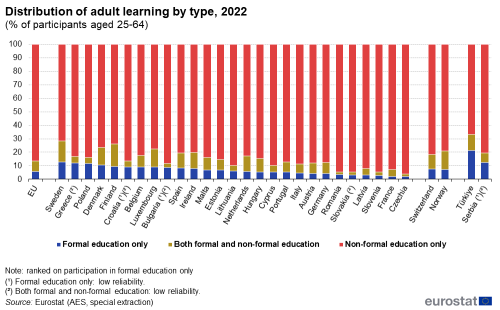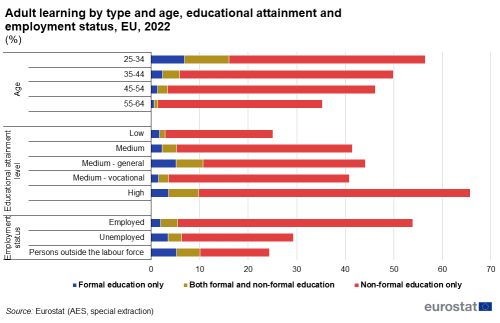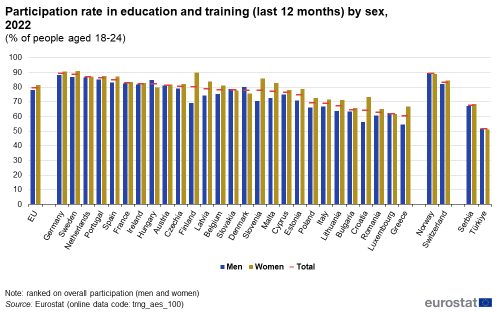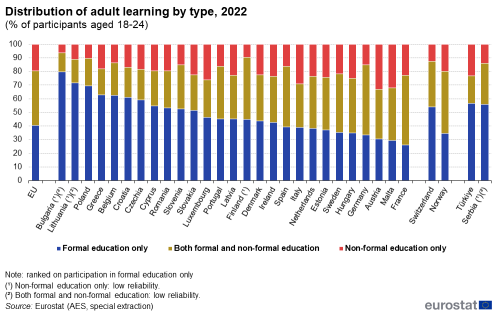Adult learning - participants
Data extracted in March 2024
Planned article update: 2030
Highlights
In the EU, 47 % of working-age adults (25-64) participated in education and training in 2022, up by 3 percentage points from 2016.
Women were more likely than men to participate in adult learning – in the EU, the participation rate in education and training was 47 % for women and 46 % for men in 2022.
86 % of participants aged 25-64 were only in non-formal learning activities.
Participation rate in education and training by sex, 2022
This article presents the main findings of European Union (EU) statistics related to adult learning. Based on the adult education survey (AES), it focuses on the level of participation in adult learning and sheds light on the characteristics of the adult learners – their sex, age, educational attainment level and labour status.
The European pillar of social rights states that everyone has the right to good education and training throughout their whole life, ensuring that everyone can get and maintain the skills necessary to participate fully in society and the labour market.
This article is one of a set of statistical articles forming part of the online publication Education and training in the EU - facts and figures, and provides a complement to information in an article on adult learning.
Full article
Almost 47 % of EU’s working age population participated in education and training
Among adults of working age (25–64), 46.6 % across the EU took part in adult learning, i.e. they participated in formal or non-formal education and training activities in 2022. This marked an increase of 2.9 percentage points (pp) compared with the previous survey, which was conducted in 2016, when 43.7 % of the working-age population had participated in adult learning. In 2011, this share was 40.2 %.
Adult learning is measured by the indicator ‘participation in education and training’ which covers participation in formal and non-formal education and training (as defined in the ISCED-11) in the last 12 months. Individuals are counted as participating if they had either participated in formal or non-formal learning activities, or in both. The main indicator refers to adults of working age, i.e. 25–64-year-olds.
In Sweden, the Netherlands, Hungary and Germany, the share of participation in adult learning was above 60 %
Among the EU Member States, there was a considerable variation between the shares of adult working-age populations who participated in formal or non-formal education or training. In 2022, by far the highest proportion was recorded in Sweden (73.9 %), followed by the Netherlands (65.2 %), Hungary (62.4 %) and Germany (60.4 %). Another 10 EU countries reported participation rates above the EU average of 46.6 %, while another 10 EU countries had rates between 25 % and the EU average. The lowest rates – below 25 % – were observed in Poland (24.3 %), Bulgaria (20.6 %) and Greece (16.6 %) (see Figure 1).
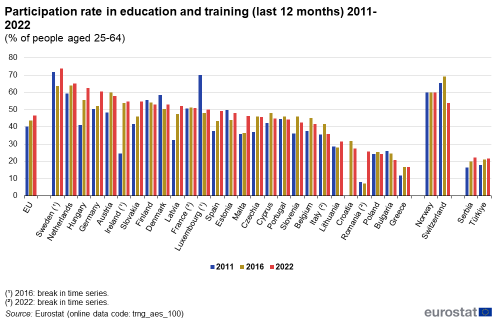
(% of people aged 25-64)
Source: Eurostat (trng_aes_100)
Compared with 2016, participation rates increased in 14 EU countries, with Sweden, Malta, Slovakia and Germany reporting the strongest percentage growth. In contrast, Bulgaria and Croatia recorded the largest declines. A strong decline compared with 2016 can also be seen in Switzerland. However, data for Switzerland refer to 2021 and are probably impacted by the Covid-19 situation at that time.
Women were more likely to participate in education and training than men
In 2022, the participation rate in education and training was 47.2 % for women and 46.0 % for men, resulting in a relatively small gender gap of 1.2 pp in favour of women. The participation rate of women was above the one of men in 21 EU countries. Within these countries, the gender gap in favour of women was greatest in the Baltic countries and Finland (10.0 pp and more). With a gender gap of +/- 1 pp, women and men had about the same likelihood of participating in formal or non-formal education and training in Germany, Denmark, Malta and Romania. In contrast, participation rates for men were higher than those for women in the following six EU countries: Slovakia, Portugal, Italy, Czechia, Hungary and Cyprus. Among these countries, the largest gender gaps were observed in Cyprus (-17.7 pp) and Hungary (-7.8 pp).
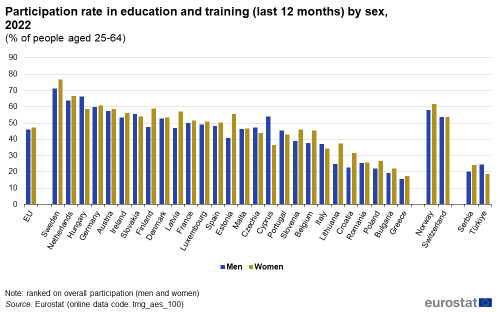
(% of people aged 25-64)
Source: Eurostat (trng_aes_100)
The younger, the higher educated and the employed were more likely to participate in adult learning
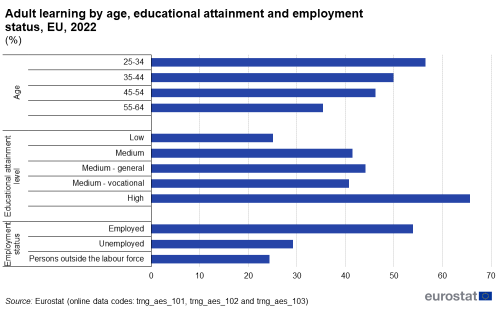
(%)
Source: Eurostat (trng_aes_101), (trng_aes_102) and (trng_aes_103)
Participation in education and training decreased with age, …
In the EU, looking at adults of working age (25-64), the highest participation rate in education and training was observed for younger adults in this group: 56.5 % for those aged 25-34. The participation rate in the following 10-year age group (age 35-44) was slightly lower (-6.6 pp) and stood at 49.9 % in 2022, followed by an even lower rate of 46.2 % for those aged 45-54. Finally, at 35.4 %, a considerably lower participation rate (-10.8 pp) was recorded for the oldest age group (55-64).
… increased with the level of educational attainment, …
Looking at participation rates of persons with different levels of educational attainment revealed that those with a higher level of education were more likely to participate in education and training. The differences in participation rates by level of education were quite substantial: 65.7 % of those with tertiary education participated in formal or non-formal learning activities in 2022, while only 25.1 % of those with a low level of education participated. The participation rate of individuals with medium education stood at 41.5 %. In this group, those with a qualification from a programme of general studies were more likely to participate (44.1 %) than those with a qualification in vocational studies (40.7 %).
… and being employed doubled the likelihood of participating in adult learning
In the EU, the participation rate of employed individuals aged 25-64 was 53.9 %. With a participation rate of 29.2 %, the unemployed were far less likely to participate in formal or non-formal learning than the employed. Least likely to participate were individuals outside the labour force in the same age group (24.4 %). An explanation for this is provided when breaking down participation by type, as this shows that the majority of adult learning is job-related and often also employer-sponsored non-formal learning, as shown in the article on characteristics of education and training.
Non-formal learning activities made up the majority of adult learning
For adults aged 25-64, the participation rate in non-formal education was seven times higher than the rate for formal education
Adult learning covers formal and non-formal education and training activities, and a person might have participated either in formal or in non-formal learning activities, or in both. That's why the participation rate in formal and non-formal education and training is less than sum of the participation rate in formal learning activities and the participation rate in non-formal learning activities. As presented in Figures 4 and 5, non-formal education and training clearly makes up the vast majority of adult learning. The participation rate in non-formal education and training stood at 44.0 % and was almost seven times higher than the rate for formal education (6.3 %). The difference was less marked in Denmark, Finland and Sweden: there, participation rates in non-formal education and training were less than 4 times higher than the rates for formal education. On the contrary, the gap was most pronounced in Czechia, Slovenia, Slovakia and Romania where the rates for non-formal education were more than 15 times higher than the rates for formal education.
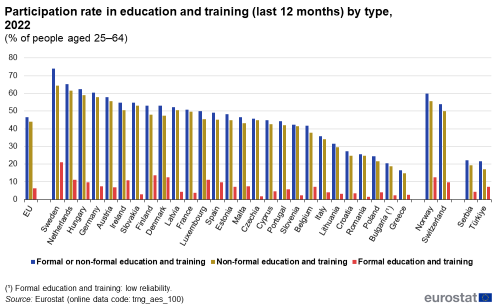
(% of people aged 25-64)
Source: Eurostat (trng_aes_100)
Formal education contributed only 13.5 % to the overall participation of 25-64 years-old
Among working-age adults, participation in formal education contributed only 13.5 % to overall participation: 5.6 % of the participants were in formal education only and another 7.9 % were in both formal and non-formal education. However, the vast majority of participants (86.5 %) were solely in non-formal learning activities. Formal education contributed more than 20 % to the overall participation in Sweden, Finland, Denmark and Luxembourg while it contributed less than 6 % in Czechia, Slovenia, Romania and Slovakia.
Formal education plays a stronger role for younger people and those outside the labour force
Taking a closer look at participation by type for different age groups, levels of education and labour status brings to light the fact that non-formal education and training was the most prominent type across all breakdowns. As one would expect, relatively higher participation rates in formal education were recorded for the younger population, for those with either a medium level of education with general studies (such as ‘baccalauréat’ or ‘Matura’) or who already hold a tertiary degree (e.g. a bachelor) and for those outside the labour force.
And what about participation in education and training of those aged 18-24?
As expected, in this age group participation rates were substantially higher than for adults of working age (25-64), as the transition into the working life is often still ahead of them.
For the EU, the participation rate in education and training of 18-24 years-old was almost 80 %. Across the EU countries, this rate ranged from over 85 % in Germany, Sweden, the Netherlands, Portugal and Spain to below 65 % in Bulgaria, Croatia, Romania, Luxembourg and Greece.
In 2022, the participation rate in education and training stood at 81.6 % for young women and 78.2 % for young men, resulting in a gender gap of 3.4 pp in favour of women. The participation rate of women was above that of men in 23 EU countries. Within these countries, the gender gap in favour of women was greatest in Malta, Greece, Slovenia, Croatia and Finland (10.0 pp and over). In contrast, participation rates of men were higher than that of women in the following four EU countries: Luxembourg, Slovakia, Denmark and Hungary. Among these countries, the largest gender gaps were observed in Hungary (-4.9 pp) and Denmark (-4.5 pp).
Unlike the 25-64 years-olds, formal education plays a major role for those aged 18-24. In this age group, the majority of participants were in formal education - around 40 % of the participants were in formal education only, another 40 % were in both formal and non-formal learning activities, and the remaining 20 % were in non-formal education only. Accordingly, the participation rate for only non-formal education and training was relatively low, at 15.5 %, a significant contrast to the working-age adults (25-64), where 40.3 % participated solely in non-formal learning (see Figure 8 and 5).
Source data for tables and graphs
Data sources
The adult education survey (AES) is the source of all information in this article. The AES covers adults’ participation in education and training (formal, non-formal and informal learning) and is one of the main data sources for EU lifelong learning statistics. Until 2016 AES, it covered adults of working age (25–64 years), since 2022 it covers all adults aged 18-69 years.
AES – reference period and data collection period
The survey refers to all learning activities in which respondents may have participated during a 12-month period prior to the interview. The data collection for the 2022 AES took place between June 2022 and March 2023 in the majority of countries. For simplicity, data are referred to as “2022” in this article.
AES – waves
Four waves of the AES have been implemented so far, in 2007, 2011, 2016 and 2022. The first was a pilot exercise and was carried out on a voluntary basis, while since 2011, AES is underpinned by legal acts: Commission Regulation (EU) No 823/2010 for 2011 AES, Commission Regulation (EU) No 1175/2014 for 2016 AES, and Commission Implementing Regulation (EU) 2021/861 for 2022 AES.
Classification
Levels of educational attainment
Common definitions for education systems have been agreed between the UNESCO Institute for Statistics (UIS), the OECD and Eurostat. UNESCO developed the International standard classification of education (ISCED) to facilitate comparisons across countries on the basis of uniform and internationally agreed definitions. In 2011, a revision to the ISCED was formally adopted, referred to as ISCED 2011. Prior to this, ISCED 1997 was used as the common standard for classifying education systems. For more information, see the article on the ISCED classification.
Levels of educational attainment are as follows
- less than primary, primary or lower secondary level of education (ISCED 2011 levels 0–2; referred to as a low educational attainment level or low level of education);
- upper secondary or post-secondary non-tertiary education (ISCED 2011 levels 3 and 4; referred to as medium educational attainment level or medium level of education); at this level, information whether the programme had general or vocational orientation is available;
- tertiary education (ISCED 2011 levels 5–8; referred to as a high educational attainment level or high level of education).
Key concepts – formal and non-formal education and training
The fundamental criterion to distinguish learning activities from non-learning activities is that the activity must be intentional (and not by chance — ‘random learning’), in other words, a deliberate search for knowledge, skills, competences or attitudes.
Broad categories of learning activities are defined in the International Standard Classification of Education 2011 (ISCED 2011). The Classification of learning activities (CLA) provides further details, in particular for non-formal learning activities.
- Formal education and training is defined as “education that is institutionalised, intentional and planned through public organisations and recognised private bodies and – in their totality – constitute the formal education system of a country. Formal education programmes are thus recognised as such by the relevant national education authorities or equivalent authorities, e.g. any other institution in cooperation with the national or sub-national education authorities. Formal education consists mostly of initial education. Vocational education, special needs education and some parts of adult education are often recognised as being part of the formal education system.” (ISCED 2011)
- Non-formal education and training is defined as “education that is institutionalised, intentional and planned by an education provider. The defining characteristic of non-formal education is that it is an addition, alternative and/or complement to formal education within the process of the lifelong learning of individuals. It is often provided to guarantee the right of access to education for all. It caters to people of all ages but does not necessarily apply a continuous pathway-structure; it may be short in duration and/or low-intensity, and it is typically provided in the form of short courses, workshops or seminars. Non-formal education mostly leads to qualifications that are not recognised as formal or equivalent to formal qualifications by the relevant national or sub-national education authorities or to no qualifications at all. Non-formal education can cover programmes contributing to adult and youth literacy and education for out-of-school children, as well as programmes on life skills, work skills, and social or cultural development.” (ISCED 2011)
In short, non-formal education and training covers institutionalised taught learning activities outside the formal education system.
The CLA further distinguishes the following broad categories of non-formal education:
- non-formal programmes;
- courses (which are further distinguished into classroom instruction, private lessons and combined theoretical-practical courses including workshops);
- guided-on-the-job training.
Key concepts – labour status
In the AES, the self-perceived activity status is collected, i.e. the information if an individual is employed, unemployed or outside the labour force refers to the person’s own perception of his/her current main activity status. It does not apply criteria of a specific concept or definition, e.g. of labour market participation as defined by the International Labour Organisation as it is done in the EU labour force survey.
Tables in this article use the following notation:
- Value in italics: data value is forecasted, provisional or estimated and is therefore likely to change;
- ':' not available, confidential or unreliable value.
Context
Upskilling – Reskilling
Adults with a low level of educational attainment and a lack of skills are more likely to earn lower than average wages and are more vulnerable to the precarious nature of the labour market. These individuals often suffer from a lack of basic skills that are increasingly considered as essential for a modern-day economy: literacy, numeracy and technological skills (‘digital literacy’). Indeed, in a world that is increasingly characterised by technological change and more precarious employment opportunities, it becomes increasingly unlikely that people can rely on the skills they acquire at school/university to last them until the end of their working lives.
There are a variety of paths that people can potentially follow to gain additional education and training beyond the formal education and training system. Lifelong learning strategies imply investing in people and knowledge — promoting the acquisition of basic skills and providing opportunities for innovative, more flexible forms of learning. They aim to provide people of all ages with equal access to high-quality learning opportunities, and to a variety of learning experiences designed to increase employability, social inclusion and active citizenship.
For some people the decision to re-engage in education and training is a difficult one: it is therefore likely that a range of different approaches are required to offer participants flexible pathways. These may comprise formal, non-formal and informal learning, so that individuals engage in up-skilling or re-skilling to improve their employment opportunities and lives in general. Investment in adult skills has the potential to improve an individual’s quality of life by raising potential earnings, increase their job satisfaction and job opportunities, or promote their social mobility. From a policy perspective, adult education and training has the potential to help the EU to boost its competitiveness in globalised markets, develop a more highly skilled workforce to meet employers’ demands, keep an ageing workforce productive and move people out of welfare. Such developments are increasingly important in a global context, given the rapid increase in the level of educational attainment and skills among the workforces of emerging and developing economies.
In the Porto Social Commitment of 7 May 2021, the European Parliament, the Council of the EU, the European social partners and civil society organisations endorsed the target that at least 60 % of all adults should participate in training every year by 2030.
The right to education, training and lifelong learning is enshrined in the European Pillar of Social Rights (principle 1) which stipulates that “everyone has the right to quality and inclusive education, training and life-long learning in order to maintain and acquire skills that enable them to participate fully in society and manage successfully transitions in the labour market.” Actions and initiatives at European level provide support to national institutions and individuals to increase the participation of adults in learning and training activities.
The European Skills Agenda outlines a five-year plan to help individuals and businesses develop more and better skills and to put them to use. Actions of the skills agenda also refer to tools and initiatives to support people in their lifelong learning pathways.
Within the European employment strategy Council decision (EU) 2020/1512 revised the employment guidelines. Guideline 6 concerns “enhancing labour supply and improving access to employment, skills and competences”. Among others, this guideline calls Member States to enable everyone to anticipate and better adapt to labour-market needs, in particular through continuous upskilling and reskilling.
Direct access to
See also
Database
- Participation in education and training (educ_part)
- Adult learning (trng)
- Participation in education and training (educ_part)
Dedicated section
Methodology
Metadata
Adult education survey (ESMS metadata file — trng_aes_12m_esms)
Manuals and other methodological information
